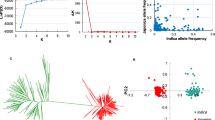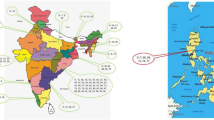Abstract
The cooking and eating quality of rice has attracted more attention recently. In a comprehensive effort to unravel its genetic basis, we conducted a genome-wide analysis of six traits representing the cooking and eating quality of rice grain, namely, amylose content (AC), gel consistency (GC), gelatinization temperature (GT), water absorption (WA), cooked rice elongation (CRE) and volume expansion (VE) using a DH population derived from the anther culture of an F1 hybrid between WYJ 2 (japonica) and Zhenshan 97B (indica). For each trait, one to three quantitative trait loci (QTL) were found, which were located on chromosomes 1, 2, 3, 6, 11. QTL analysis revealed a major QTL specifying GT, located at the interval RM276-RM121, which should be the same locus as the alkali degeneration gene (alk), while for each of the remaining five traits the QTL explaining the largest proportion of variance was located on the short arm of chromosome 6, centered at RM190 (found in the waxy gene). Our results, in combination with previous reports, further confirmed that either the waxy gene itself or a genomic region tightly linked to it plays a major role in determining the cooking and eating quality of rice.
Similar content being viewed by others
Abbreviations
- AC:
-
amylose content
- CRE:
-
cooked rice elongation
- GC:
-
gel consistency
- GT:
-
gelatinization temperature
- VE:
-
volume expansion
- WA:
-
water absorption
References
S.N. Ahn C.N. Bollich A.M. McClung S.D. Tanksley (1993) ArticleTitleRFLP analysis of genomic regions associated with cooked-kernel elongation in rice Theor. Appl. Genet. 87 27–32
B.B. Buchanan W. Gruissem R.L. Jones (2000) Biochemstry & Molecular Biology of Plants American Society of Plant Physiologists Rockville Maryland, USA
G.B. Cagampang C.M. Perez B.O. Juliano (1973) ArticleTitleA gel consistency test for the eating quality of rice J. Sci. Food Agrs. 24 1589–1594
N. Dela Cruz G.S. Khush (2000) Rice grain quality evaluation procedures R.K. Singh U.S. Singh G.S. Khush (Eds) Aromatic Rices Oxford & IBH Publishing Co. Pvt. Ltd. New Delhi, India 26–27
P. He S.G. Li Q. Qian Y.Q. Ma J.Z. Li W.M. Wang Y. Chen L.H. Zhu (1999) ArticleTitleGenetic analysis of rice grain quality Theor. Appl. Genet. 98 502–508
G.H. Jiang Y.Q. He C.G. Xu X.H. Li Q. Zhang (2004) ArticleTitleThe genetic basis of stay-green in rice analyzed in a population of doubled haploid lines derived from an indica by japonica cross Theor. Appl. Genet. 108 688–698
B.O. Juliano (1985) Rice Chemistry and Technology, 2nd ed Amercian Association of Cereal Chemists Incorporated Saint Paul, Minnesota, USA
P.D. Larkin W.D. Park (2003) ArticleTitleAssociation of waxy gene single nucleotide polymorphisms with starch characteristics in rice (Oryza sativa L.) Mol. Breeding 12 335–339
J.C. Lanceras Z.L. Huang O. Naivikul A. Vanavichit V. Ruanjaichon S. Tragoonrung (2000) ArticleTitleMapping of genes for cooking and eating qualities in Thai jasmine rice (KDML105) DNA Res. 7 93–101
S. Lincoln M. Daly E. Lander (1992) Mapping genes controlling quantitative traits with MAPMAKER/QTL 1.1, Whitehead Institute Technical Report2nd ed Whitehead Institute Cambridge Massachusetts, USA
R.R. Little G.B. Hilder E.H. Dawson (1958) ArticleTitleDifferential effect of dilute alkali on 25 varieties of milled white rice Cereal Chem. 35 111–126
C. Martin A.M. Smith (1995) ArticleTitleStarch biosynthesis Plant Cell. 7 971–985
H.S. Pooni I. Kumar G.S. Khush (1993) ArticleTitleGenetical control of amylose content in selected crosses of indica rice Heredity 70 269–280
Y.F. Tan J.X. Li S.B. Yu Y.Z. Xing C.G. Xu Q.F. Zhang (1999) ArticleTitleThe three important traits for cooking and eating quality of rice grains are controlled by a single locus in an elite hybridShanyou 63 Theor. Appl. Genet. 99 642–648
S. Temnykh W.D. Park N.M. Ayres S. Cartinhour N. Hauck L. Lipovich Y.G. Cho T. Ishii S.R. McCouch (2000) ArticleTitleMapping and genome organization of microsatellite sequences in rice (Oryza sativa L.) Theor. Appl. Genet. 100 697–712
T. Umemoto M. Yano H. Satoh A. Shomura Y. Nakamura (2002) ArticleTitleMapping of a gene responsible for the difference in amylopectin structure between japonica-type and indica-type rice varieties Theor. Appl. Genet. 104 1–8
Z.Y. Wang F.Q. Zheng J.P. Gao X.Q. Wang M. Wu J.L. Zhang M.M. Hong (1994) ArticleTitleIdentification of two transposon-like elements in rice Wx gene Sci. China B 37 437–447
Z.Y. Wang F.Q. Zhen G.Z. Shen J.P. Gao P. Snustad M.G. Li J.L. Zhang M.M. Hong (1995) ArticleTitleThe amylose content in rice endosperm is related to the post-transcriptional regulation of the waxy gene Plant J. 7 613–622
Author information
Authors and Affiliations
Corresponding author
Rights and permissions
About this article
Cite this article
Tian, R., Jiang, GH., Shen, LH. et al. Mapping quantitative trait loci underlying the cooking and eating quality of rice using a DH population. Mol Breeding 15, 117–124 (2005). https://doi.org/10.1007/s11032-004-3270-z
Received:
Accepted:
Issue Date:
DOI: https://doi.org/10.1007/s11032-004-3270-z




